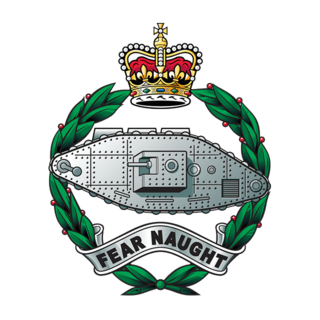
XXX Corps was a corps of the British Army during the Second World War. The corps was formed in the Western Desert in September 1941. It provided extensive service in the North African Campaign and many of its units were in action at the Second Battle of El Alamein in late 1942. It then took part in the Tunisia Campaign and formed the left flank during the Allied invasion of Sicily in 1943.
The 1st Army Tank Brigade was a formation of the British Army during the Second World War. A Tank Brigade was intended to support the Infantry and was mostly equipped with slow moving Infantry tanks, unlike an Armoured Brigade, which was equipped with faster cruiser tanks and later its own motorised infantry. Initially using infantry nomenclature for its smaller units, company and section and having 175 light and infantry tanks, it later adopted cavalry nomenclature of squadron and troop and later in the War grew to 240 tanks.

The Royal Tank Regiment (RTR) is the oldest tank unit in the world, being formed by the British Army in 1916 during the First World War. Today, it is the armoured regiment of the British Army's 12th Armoured Infantry Brigade. Formerly known as the Tank Corps and the Royal Tank Corps, it is part of the Royal Armoured Corps.

The 1st Royal Tank Regiment was an armoured regiment of the British Army. It is part of the Royal Tank Regiment, itself part of the Royal Armoured Corps and operationally under 12th Armoured Infantry Brigade.
The 7th Royal Tank Regiment was an armoured regiment of the British Army from 1917 until disbandment in 1959.

The 42nd Royal Tank Regiment was an armoured regiment of the British Army from 1938 until 1956. It was part of the Royal Tank Regiment, itself part of the Royal Armoured Corps.
The 43rd Royal Tank Regiment was an armoured regiment of the British Army's Royal Armoured Corps that tested and demonstrated specialised Armoured Fighting Vehicles during World War II.
49th Royal Tank Regiment, later 49th Armoured Personnel Carrier Regiment and 49th Armoured Carrier Regiment, was a regiment of the British Army's Royal Armoured Corps during World War II that operated specialised armoured fighting vehicles in North West Europe.

The 23rd Armoured Brigade, originally formed as the 23rd Army Tank Brigade, was an armoured brigade of the British Army that saw service during the Second World War. The brigade was a 2nd Line Territorial Army (TA) formation. It was reorganised and renamed the 23rd Armoured Brigade, when it was assigned to the 8th Armoured Division, although it never operated under command of the division.

The 22nd Armoured Brigade was an armoured brigade of the British Army that saw service during and after the Second World War. The brigade was formed on the outbreak of war on 3 September 1939 from Territorial Army (TA) armoured regiments. It saw a considerable amount of action during the war, beginning with the Western Desert Campaign where it was engaged in Operation Crusader and at the Battles of Gazala, Mersa Matruh, First Alamein and Alam el Halfa. It then joined the 7th Armoured Division for the Second Battle of El Alamein. It remained part of 7th Armoured for the rest of the war, including the campaigns in Tunisia, Italy and North West Europe. It continued in the postwar TA until 1956. The brigade's identity was re-established in the Regular Army between 1981 and 1993.

The 30th Armoured Brigade was an armoured formation of the British Army that served in Western Europe Campaign as part of the 79th Armoured Division. After the reformation of the Territorial Army in 1947, the brigade was re-created within the Territorials based in Scotland and finally disbanded by 1967.
The 131st Infantry Brigade, originally the Surrey Brigade was an infantry formation of Britain's Territorial Army that saw service during both the First and the Second World Wars. In the First World War the brigade was in British India for most of the war and did not see service as a complete unit but many of its battalions would see service in the Middle East.

The 10th Armoured Division was an armoured formation of division-size of the British Army, raised during the Second World War and was active from 1941–1944 and after the war from 1956–1957. It was formed from the 1st Cavalry Division, a 1st Line Yeomanry unit of the Territorial Army (TA) which had previously been serving in Palestine. The division was converted from cavalry to armour and redesignated from 1 August 1941.

The Derbyshire Yeomanry was a yeomanry regiment of the British Army, first raised in 1794, which served as a cavalry regiment and dismounted infantry regiment in the First World War and provided two reconnaissance regiments in the Second World War, before being amalgamated with the Leicestershire Yeomanry to form the Leicestershire and Derbyshire Yeomanry in 1957.

The 3rd County of London Yeomanry (Sharpshooters) was a Yeomanry regiment of the British Army. It was raised in 1901 from Second Boer War veterans of the Imperial Yeomanry. During the First World War it served dismounted at Gallipoli, was remounted to serve in Macedonia, Egypt and Palestine, before being converted to machine gunners for service on the Western Front. 2nd and 3rd Line units remained in the United Kingdom throughout.

The Northumberland Hussars was a Yeomanry regiment of the British Army, transferred to the Royal Artillery for the duration of the Second World War. It was disbanded as an independent Territorial Army unit in 1967, a time when the strength of the Territorial Army was greatly reduced. The regiment's name lives on in the title of the command and support squadron of the Queen's Own Yeomanry (QOY), a Formation Reconnaissance Regiment based in Newcastle upon Tyne.
Major-General Arundell Rea Leakey, was an officer in the British Army. He served in the Royal Tank Regiment in the Second World War, in North Africa, Italy and France. He later served in Korea, in the Arab Legion, and commanded a brigade in the British Army of the Rhine in the 1960s. He served as Director-General of Fighting Vehicles and finally as the commander of British troops in Malta and Libya. He retired in 1966, and became Director of the Wolfson Foundation. An autobiography, Leakey's Luck, was published in 1999.

The 31st Armoured Brigade was an armoured brigade formation of the British Army, created during the Second World War.












